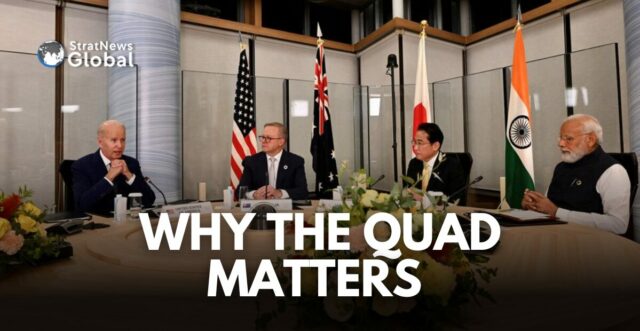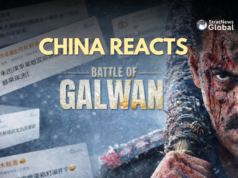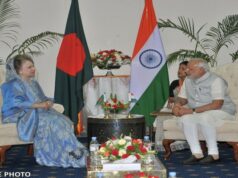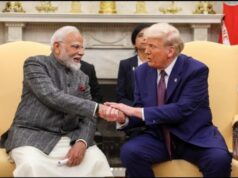The Quad, as is well known, was born out of an immediate need to help several coastal areas right across the Indian Ocean following the devastation caused by the 26 Dec 2004 Tsunami. Its objective was to provide Humanitarian Assistance and Disaster Relief (HADR) mainly to Indonesia, Thailand, Sri Lanka and the Maldives.
Among the four countries, Australia, Japan, India and the US which rallied and coordinated their resources, only India had itself suffered badly in the Andaman and Nicobar-island group, and along the peninsular east coast and even on the west coast. It also deployed not only in India but in a few other countries and was ‘the firstest with the mostest’ in a manner of speaking.
While the Quad became almost moribund after that, the idea of the Indo-Pacific developed anew. Let us not spend time on the reasons for the Quad’s “coma” here, but rather jump to 2017 when it began a revival and then, especially from 2021 when a new, proactive agenda took shape.
The three prime ministers and the US president met in Tokyo in 2022 and issued a strong joint statement that set forth many concrete plans and programmes across a range of activities that will bring several benefits to much of the Indo-Pacific, both as a maritime space that connects different nations and peoples and for the lands in which we live.
The joint statement was significant because in the 2019 meetings such statements were not made. The joint statement at the end of the 29 July 2024 foreign ministers’ meeting, again in Tokyo, strengthens and expands “a positive and practical agenda” and expresses shared concerns in more robust ways than any time before.
“Not Against but About China”
Although the statement does not mention China—arguably it does not need to—it flags issues of concern that directly point to China’s attitudes and actions in the South and East China Seas; the non-adherence to international conventions that govern the sea (UNCLOS, for example) and disregard for rulings in support of the Philippines. It also flags the “dangerous use of coast guard and maritime militia vessels” something China is known to do.
At the same time, it may be understandable not to mention China for one important reason. This writer has earlier mentioned that the Quad is “not against China but about China.” So, it is not China itself, but Chinese actions and their impact that are being flagged.
Also, the Quad seeks to provide larger human goods to the region; it need not focus on China. Rather, it adroitly offers the benefit of a positive agenda in several areas.
The most important, widely encompassing public good is furthering the ‘freedom of the Indo-Pacific” (FOIP)). Not only nations within the Indo-Pacific, but beyond are benefited by the free flow of trade. In fact, the Quad leadership has clearly understood that the maritime commons and such freedoms are intricately related to the other two commons, the cyber and space commons.
For much of the globe, physical trade between nations moves by sea in ships.
What is sometimes more difficult to keep in mind is that trade in services is carried out mainly via data cables that snake through sea and oceanic bottoms with a length currently estimated to be about 1.5 million kilometers that carry almost inestimable brontobytes of data all the time.
These two aspects of maritime commons have a physicality that needs to be maintained, protected and keep working even through natural and man-made adversity like geopolitical tension and conflict.
The space common is also very much on the Quad’s agenda in upholding the importance of space treaties and for international cooperation in sharing of space technologies and the fruits of outcomes for the larger good. Satellites are central to the system of information gathering and sharing, for transportation safety and operations of vessels, vehicles, ships and aircraft, again for the larger benefit.
In tandem is the third common, cyber-space where measures are being put in place so that nations are together able to prevent cyber-attacks and protect the functioning in the maritime commons as well as on land from state and non-state groups or even individuals. In a world which is digitized more by the hour, safeguards and standards must be mutually ensured.
A Slew of Initiatives
More specifically, within the maritime domain, the stress is on enhancing the Indo-Pacific Partnership for Maritime Domain Awareness (IPMDA). This will further the benefits of navigational safety, security of shipping, protections against illegal, unlawful and unregulated fishing (IUU) to ensure food security by ‘sustain(ing) their fisheries” (2022 Statement).
It would be unwise to let countries with large deep-sea and ocean-going fishing fleets (like China, for instance) to range unhindered, denuding tomorrow’s stocks today from areas that are for all humankind.
In tandem, there are concrete Quad plans to bring Pacific Island nations, SE Asian and IOR nations (with cooperation between PIF, ASEAN and IORA) to more deeply interlink information fusion centres for improved maritime domain awareness.
In time, one hopes that the Quad Maritime Security Working Group finalises cooperative steps and coordination among the various agencies working to ensure prosperity with security for all. The maritime legal dialogue that the Quad ministers want to launch ‘to uphold the rules-based maritime order in the Indo-Pacific” could be an important step.
Digital trade requires cooperation across entities, public as well as private and across the world. The complex structure of undersea cable networks that patch on to terrestrial and space- enabled connectivity, their role in daily human lives is ubiquitous as well as under-realised.
As a subset, therefore of this complexity, the Quad Partnership for Cable Connectivity and Resilience is very important. The setting up of a Cable Connectivity and Resilience Centre in Australia and the “training of over 1000 telecom officials and executives under the CABLES program” (of the US) have been supported by finance and pooling of technical expertise from Quad constituents and other countries.
The training and deployment of experts is furthered by Quad fellowships in several disciplines that further resilience in public infrastructure, financial services, cyber defence, natural disasters, climate change, etc. In some ways, it is a different version of the older Colombo Plan that helped build expertise and create change for the better through expertise- building.
In the cyber common, the ministerial statement said, “We reaffirm our commitment to a more open, secure, stable, accessible and peaceful cyberspace.” This is to be executed, among other things, by the setting up of the Quad Cyber Ambassadors’ group to discuss “responsible State behaviour in
cyberspace.”
Training to ensure capacity building will be through measures like a ‘Quad Cyber Bootcamp’ in India. Enhanced resilience and security are goals for cyber-strengthening infrastructure, networks and even developing more “trusted vendors.” There are other initiatives in matters of climate change, freedom of information, communications security, HADR, counterterrorism, clean energy and so on, that space does not permit expansion here.
The Bogey of an “Asian NATO”
Quad detractors and Quad-cynics have found it convenient to term the Quadrilateral Security Dialogue as an “Asian NATO.” They may continue to do so but the circumstances of setting up, the objectives and the focus of NATO from 1949 were very different. If anything, the objectives of the Quad are closer to the motivations that created the US legislation, the Economic Recovery Act 1948, better known as the Marshall Plan. Yet, there are departures here as well.
The circumstances of World War II devastated Europe do not exist in the Indo-Pacific; revival/ recovery is not a need but resurgence and resilience for all are desirable objectives. The attached argument offered is that the BRI (of 2013 vintage) offers public goods to all who wish to sign up.
Enough has been written and said about the problems of the BRI in conception; its single-nation financial backing; the debt repayment difficulties; the under-used infrastructure often called ‘white elephants’; the strings seemingly attached and as important, the domestic political arguments, especially during elections, that come to the fore about Beijing’s influence.
From Four to Many
This analyst does not know if there can be a Latin or Sanskrit equivalent of “From four to many” as there is for the American motto, “E Pluribus Unum,” or ‘out of many, one.’ But the four democracies (often called maritime democracies) bring to the table of geopolitics are very different set of values, legal fundamentals, forms of government, and even habits of cooperation that are so deep and commonplace that they are taken for granted.
As mentioned elsewhere by this writer, the Quad does not need to be inclusive in its membership, because it is inclusive in its agenda. This line is not intended to be catchy but to merely describe the larger common good that it seeks to achieve with the help of ASEAN, PIF, IORA and so on. Their acceptance of the Quad as such a framework is now more evident.
Let us think, for a moment, if there is likely to be a situation anywhere resembling vexed discussions on a Quad and ASEAN Code of Conduct as is ongoing between it and China?
Related, is a preference to talk about the numerous “Quad” military exercises.
This label is not an official one. Three points can be made here:
First, there are now four members of the Malabar series of exercises that are the same as the Quad constituents. However, the Malabar series began as a bilateral exercise between India and the US from 1992. It was only in the mid-2000s that it occasionally included these four and once, Singapore.
Only in the last few iterations have Australia and Japan become now regular participants in the Malabar series. While these exercises are focused on the maritime domain, they are getting to be more multi-service and multi-dimensional because defence readiness is increasingly so.
Second, in a sense much larger than defence relationships, the six bilateral relationships within the four Quad members predate the Quad, and form the girders that support the Quad architecture. We seem to be at a stage now where the bilateral and quadrilateral relationships are mutually supporting while remaining mutually exclusive in some ways.
Third, there are treaties between the US and Japan and Australia which have mutual defence agreements not unlike Article 9 of the August 1971 Indo-Soviet Treaty of Friendship, now defunct for many years. Thus, there are between them sort of mini-NATOs without the strong provisions of Article 5 of the NATO.
Even for India, there are a host of bilateral, trilateral and multi-lateral partnerships and associations it is a part of, in which the three others may not necessarily be participants. So, while the Asian NATO argument will be trotted around for long, it has no real traction.
Conclusion
The Quad now seems to have matured to a stage where it may benefit from at least a quasi-formal secretariat; executive and scholarly support; and moving forward in a deliberate, discernible and acceptable ways across nations and peoples of the Indo-Pacific and actualize its “From Four to Many” values and benefits.





